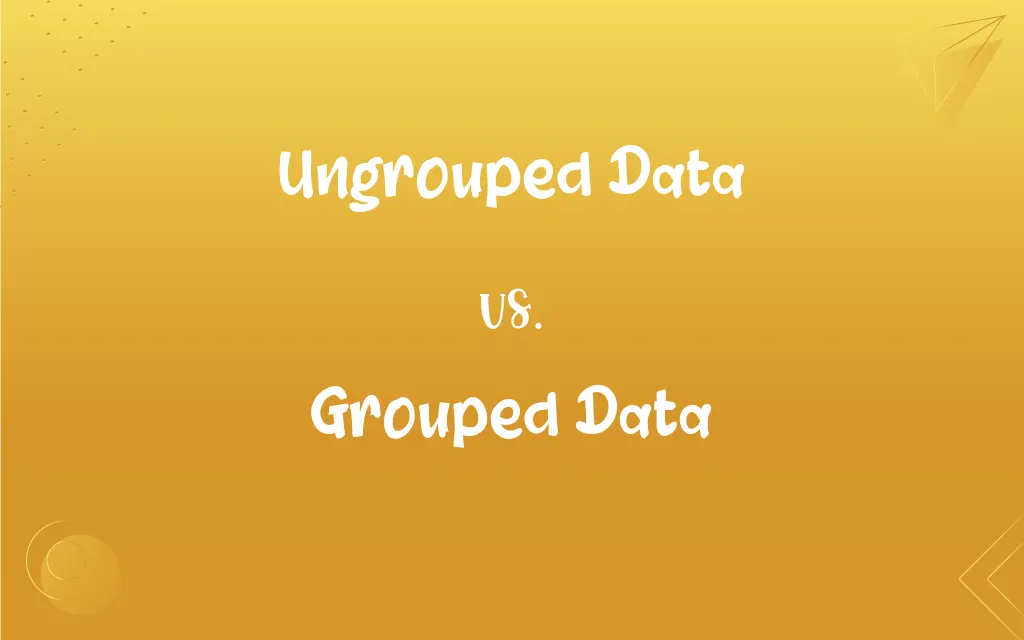Ungrouped Data vs. Grouped Data: What's the Difference?
Edited by Janet White || By Harlon Moss || Published on November 25, 2023
Ungrouped Data is raw data collected in its original form. Grouped Data is organized into categories or intervals.

Key Differences
Ungrouped data is the raw data as it is collected, in its original and unorganized form. Grouped data, conversely, is when this raw data is organized into categories or intervals for easier analysis and interpretation.
Ungrouped data reflects individual data points and their specific values. Grouped data, on the other hand, summarizes these individual points into groups, often losing some specific details in the process.
Analyzing ungrouped data can be more complex due to its detailed nature, as each data point is considered separately. In contrast, grouped data simplifies analysis by categorizing similar data points, making patterns more apparent.
Ungrouped data is more suitable for small datasets where specific details are important. Grouped data is preferable for large datasets to identify trends and general patterns.
While ungrouped data provides a more granular view, grouped data offers a broader perspective, often essential for statistical analysis and hypothesis testing.
ADVERTISEMENT
Comparison Chart
Form
Raw, individual data points
Categorized into intervals or groups
Detail Level
More detailed, specific
Less detailed, summarized
Analysis Complexity
Higher for large datasets
Simpler, especially for large datasets
Data Size Suitability
Better for smaller datasets
Better for larger datasets
Purpose
Detailed analysis, specific insights
Broad analysis, identifying trends
ADVERTISEMENT
Ungrouped Data and Grouped Data Definitions
Ungrouped Data
Original data collected without any categorization.
A list of individual student scores on a test is ungrouped data.
Grouped Data
Data arranged in intervals or classes.
Income levels of individuals categorized into ranges form grouped data.
Ungrouped Data
Individual data entries without any grouping or summarization.
A record of each sale transaction in a store is ungrouped data.
Grouped Data
Data clustered into segments for pattern identification.
Survey responses categorized by age groups are grouped data.
Ungrouped Data
Data where each entry is distinct and not part of a category.
Responses to a survey question listed individually are ungrouped data.
Grouped Data
Data where individual points are combined into groups.
Sales transactions summarized by week are grouped data.
Ungrouped Data
Raw data points collected individually.
Daily temperature readings over a month represent ungrouped data.
Grouped Data
Data organized into categories or intervals.
Student scores categorized by grade ranges represent grouped data.
Ungrouped Data
Data in its most basic, unorganized form.
Customer feedback forms collected are ungrouped data.
Grouped Data
Summarized or categorized data for easier analysis.
Temperature readings grouped into weekly averages are grouped data.
FAQs
Can ungrouped data be converted into grouped data?
Yes, ungrouped data can be organized into categories to create grouped data.
Is grouped data less accurate than ungrouped data?
Grouped data might lose some specific details but is not necessarily less accurate.
What is the primary difference between ungrouped and grouped data?
Ungrouped data is raw and detailed, while grouped data is organized into categories.
Is grouped data easier to visualize?
Yes, because it summarizes data into categories, making it easier to visualize.
Does converting to grouped data always involve losing some data precision?
Generally, yes, as details are summarized into broader categories.
Can ungrouped data be used for hypothesis testing?
Yes, but grouped data is often more practical for such tests.
Does ungrouped data provide more detailed information?
Yes, ungrouped data maintains all original details of each data point.
Why is grouped data often used in statistical analysis?
Grouped data simplifies analysis and helps in identifying trends and patterns.
Can grouped data be disaggregated back into ungrouped data?
Not exactly, as some specific details may be lost in the grouping process.
Is ungrouped data more suitable for individual case studies?
Yes, due to its detailed nature.
Does grouped data help in making generalizations?
Yes, as it summarizes data into broader categories.
Is grouped data more useful for trend analysis?
Yes, as it simplifies data into categories suitable for identifying trends.
Can ungrouped data be used for large datasets?
Yes, but its analysis can be complex compared to grouped data.
Can ungrouped data identify outliers more easily?
Yes, since it maintains individual data point details.
Can both ungrouped and grouped data be used in the same study?
Yes, depending on the research objectives and methods.
Are there any disadvantages to using grouped data?
Grouped data can obscure specific details and individual data point variations.
Is ungrouped data preferable for small-scale research?
Often, yes, due to its detailed nature.
Is there a specific method to group ungrouped data?
Grouping methods depend on the data type and the analysis objectives.
Can ungrouped data be graphically represented?
Yes, but it might be less clear than graphical representations of grouped data.
Are histograms used for ungrouped or grouped data?
Histograms are used for representing grouped data.
About Author
Written by
Harlon MossHarlon is a seasoned quality moderator and accomplished content writer for Difference Wiki. An alumnus of the prestigious University of California, he earned his degree in Computer Science. Leveraging his academic background, Harlon brings a meticulous and informed perspective to his work, ensuring content accuracy and excellence.
Edited by
Janet WhiteJanet White has been an esteemed writer and blogger for Difference Wiki. Holding a Master's degree in Science and Medical Journalism from the prestigious Boston University, she has consistently demonstrated her expertise and passion for her field. When she's not immersed in her work, Janet relishes her time exercising, delving into a good book, and cherishing moments with friends and family.































































